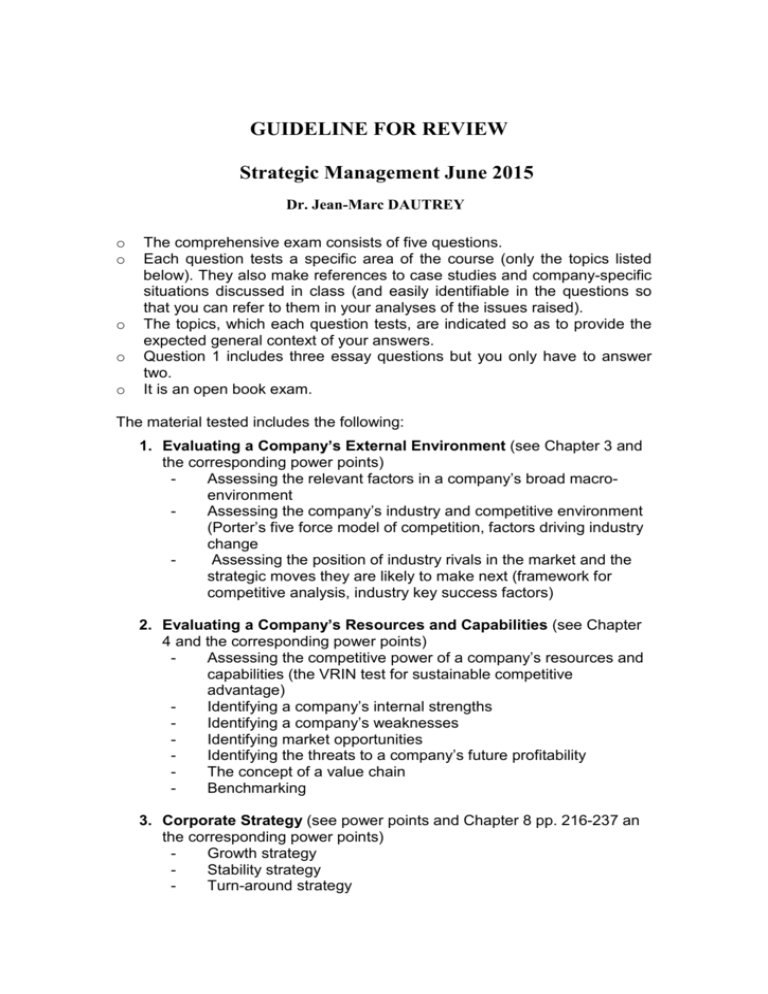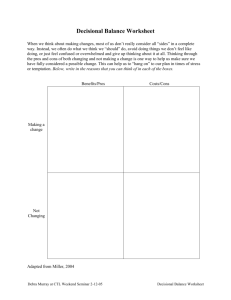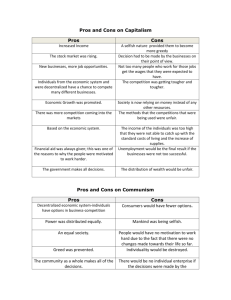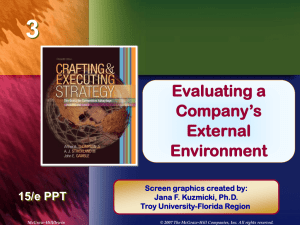Dr. Jean-Marc Marcel Dautrey
advertisement

GUIDELINE FOR REVIEW Strategic Management June 2015 Dr. Jean-Marc DAUTREY o o o o o The comprehensive exam consists of five questions. Each question tests a specific area of the course (only the topics listed below). They also make references to case studies and company-specific situations discussed in class (and easily identifiable in the questions so that you can refer to them in your analyses of the issues raised). The topics, which each question tests, are indicated so as to provide the expected general context of your answers. Question 1 includes three essay questions but you only have to answer two. It is an open book exam. The material tested includes the following: 1. Evaluating a Company’s External Environment (see Chapter 3 and the corresponding power points) Assessing the relevant factors in a company’s broad macroenvironment Assessing the company’s industry and competitive environment (Porter’s five force model of competition, factors driving industry change Assessing the position of industry rivals in the market and the strategic moves they are likely to make next (framework for competitive analysis, industry key success factors) 2. Evaluating a Company’s Resources and Capabilities (see Chapter 4 and the corresponding power points) Assessing the competitive power of a company’s resources and capabilities (the VRIN test for sustainable competitive advantage) Identifying a company’s internal strengths Identifying a company’s weaknesses Identifying market opportunities Identifying the threats to a company’s future profitability The concept of a value chain Benchmarking 3. Corporate Strategy (see power points and Chapter 8 pp. 216-237 an the corresponding power points) Growth strategy Stability strategy Turn-around strategy - Diversification strategy (related/unrelated/ by acquisitions, joint ventures) Parenting Portfolio management Economies of scope 4. The Five Generic Competitive Strategies (see Chapter 5 and the corresponding power points) Low cost provider strategies (major avenues for achieving a competitive advantage based on lower costs) Broad differentiation strategies (major avenues to a competitive advantage based on differentiating a company’s product or service offering from the offerings of rivals) Focused (market niche) strategies (major avenues for a competitive advantage based on lower costs) Best-cost provider strategies (the attributes of a best-cost provider strategy as a hybrid of low-cost provider and differentiation strategies) Please not that these five strategies have also been referred to as business strategies as they apply to the business units of a large conglomerate (and complement its corporate strategy) and to SMEs. 5. Timing a Company’s Offensive and Defensive Strategic Moves (see Chapter 6/ pp. 155-174 and the corresponding power points) First-mover advantages/ disadvantages Late-mover advantages/ disadvantages Merger and acquisition strategies (pros and cons) Vertical integration strategies (pros and cons) Outsourcing strategies (pros and cons) Strategic alliances and partnerships (benefits and drawbacks) 6. Strategies for Competing in International Markets (see Chapter 7/ pp. 188-198 and the corresponding power points) Strategic options for entering and competing in international markets (export. licensing, franchising, foreign subsidiary, alliance and joint venture strategies) Multi-domestic, global, and transnational strategies In addition to the book (only the chapters indicated above) and the course power points, also review you notes (most notably the examples and case studies discussed in class).








